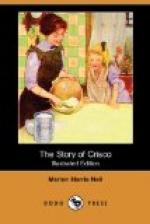A proper set of carving tools is almost indispensable, and should comprise: a good thin, sharp-bladed knife, a solid two or three pronged fork, and a pair of carving scissors. Anything that needs to be carved at table should be placed on a dish sufficiently large to allow the joint to be turned without moving the dish from its position. The dish should be placed close in front of the carver. Such joints as beef, veal and ham should be cut very thin; while lamb, mutton, and pork should be cut a trifle thicker.
To carve a fowl, begin by sticking the fork into the pinion and draw it towards the leg; and then, passing the knife underneath, take off the wing at the joint. Next slip the knife between leg and body, to cut through the joint; and with the fork turn leg back, and joint will give way. Then take off other wing and leg. After legs are taken off, enter knife into the top of breast, and cut under merrythought or wishbone so as to loosen it, lifting it with the fork. Afterwards cut slices from both sides of breast. Next, take off collarbones, which lie on each side of wishbone and then separate side bones from the back. The breast and wings are considered the most delicate parts; the back as the least desirable, generally is left on platter.
A turkey is carved in same manner, except that the legs and wings, being larger, are separated at lower joint. Lower part of leg (or drumstick) being hard, tough, and stringy, usually is allowed to remain on platter. First cut off wing, leg, and breast from one side; then turn turkey round and cut them off from the other.
To carve a goose, separate leg from body by putting fork into small end of leg, pressing it close to body, and then passing knife under, and turning leg back as you cut through joint. To take off wing, put fork into the small end of wing, and press it closely to body, then slip knife under and separate the joint. Next, cut under wishbone and take it off, and cut slices from breast. Then turn and dismember the other side. Take off upper side bones next to wings, then two lower side bones. The breast and legs of a goose are considered the most choice. If a goose is old, there is no fowl so tough.
Quails merely are split down the back, as also are pigeons, giving a half to each person.
To carve loin of mutton, a portion is cut through, beginning at the best end. If kidney be in it, a slice should be served as far as it will go to each portion. Care must be taken that the bone is well jointed. The butcher chops the loin between each vertebra. When big mutton is carved it gives a large chop, oftentimes more than the amount desired, but a chop cannot be divided without waste, or one portion being all the inferior end. It is therefore a good plan to joint a loin of mutton with a small meat saw, cutting any thickness desired. In this case the actual bone will often have to be sawn through. The result will be more economical, and the servings more agreeable. The loin also can be boned entirely, stuffed or not, as preferred, the flap end folded and fastened over the fillet portion. Then the meat can be carved across any thickness.




